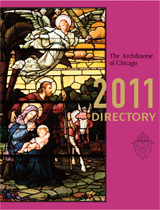Golden Rice Bowl honors priest for doing good

A regular feature of The Catholic New World, The InterVIEW is an in-depth conversation with a person whose words, actions or ideas affect today's Catholic. It may be affirming of faith or confrontational. But it will always be stimulating.
Father Richard Valker was an associate pastor at St. Norbert Parish in Northbrook when he first heard about Operation Rice Bowl, Catholic Relief Services’ annual Lenten program to raise money for anti-hunger programs around the world while raising awareness about global hunger.
He brought the program back to his parish, which has consistently offered a high level of support for Operation Rice Bowl.
Now retired for seven years, Valker still resides at St. Norbert and still coordinates Operation Rice Bowl. He will receive the first-ever Golden Rice Bowl Award from retired Auxiliary Bishop Raymond Goedert in a ceremony at 10 a.m. Feb. 10 at the Archbishop Meyer Center, 3525 S. Lake Park Ave.
Adrienne Curry, the archdiocese’s program director for Catholic Relief Services and justice education, said he was selected because his parish consistently donates $10,000 to Operation Rice Bowl each year.
Valker spoke about his involvement in Operation Rice Bowl with assistant editor Michelle Martin.
Catholic New World: Why were you selected to the be the first recipient of the Golden Rice Bowl?
Father Richard Valker: This award isn’t really about me. It’s about the people of St. Norbert’s Parish. I started it years back, after a meeting about it down at St. Theresa’s. It’s become kind of a nice tradition.
CNW: How does St. Norbert Parish participate in Operation Rice Bowl?
Valker: We put a rice bowl in all of the bulletins the Sunday before Lent, so everyone who gets a bulletin gets one. Then we go through the school and give a Rice Bowl to each student. We also have a team of people who visit each classroom and give a five-minute talk on rice bowl and what it is for, to encourage the kids to give to the hungry of the world.
We do the same thing in the religiouseducation program for the public school kids, and we have the same team give the five-minute talks.
CNW: Are most of the people who participate children from the school or religious-education classes?
Valker: One of the geniuses of the program is that the wealthy donors in the parish can give something, and the smallest child can give something. We encourage people to give sacrificially – don’t get the popcorn when you go to the movies; that’s four or five bucks right there that can go in the Rice Bowl.
The donations are the fruit of the mortifications we give in Lent. We ask people to keep them on their dining room tables so they won’t forget them and return them Palm Sunday.
CNW: How many Rice Bowls do you get back?
Valker: I’ve never counted. But we usually get $9,000 to $10,000 each year in donations. We’ve done pretty well with it. I think people look forward to it.
We have a couple of fairly big donations, but a lot of it comes in the coins from the kids. We take all that coin, all that copper, off to the bank. I think they hate to see me coming because they have to count all of it.
CNW: What make Operation Rice Bowl so successful in your parish?
Valker: In addition to the rice bowls, we use the calendars that Catholic Relief Services gives out.
There are people in the parish who are happy to give the talks. I think they’ve gotten good at it over the years, telling the children the story of children who are hungry. I also have to give my appreciation to the principal at the school and our religious-education director, who give us time out of their classes to talk about this.
I think the Rice Bowl itself is part of why it works. It’s a cool thing. It comes as a cardboard sheet and you have to put it together. The kids like to make the little bank. It’s kind of hard — you’ve got to sort of be a Philadelphia lawyer to do it.
What is Operation Rice Bowl?
Operation Rice Bowl, the official Lenten program of Catholic Relief Services, began in 1975 in the Diocese of Allentown, Pa., as a response to the drought in the African Sahel. For 34 years, Operation Rice Bowl has called participants to pray with their families and faith communities; fast in solidarity with those who hunger; learn about our global community and the challenges of poverty overseas, and give sacrificial contributions to those in need.
Operation Rice Bowl offers Catholics in the United States a way to connect with brothers and sisters overseas.
Over the past 34 years, $167 million has been collected through Operation Rice Bowl to support CRS’ development projects that improve peoples’ ability to access food, overseas and in local diocesan communities in the United States. Each Lent, more than 13,500 faith communities across the United States participate in Operation Rice Bowl as a way to respect human dignity and foster solidarity with the poor around the world.
Seventy-five percent of Rice Bowl proceeds come to Catholic Relief Services and help fund development projects designed to increase food security in communities in over 40 countries around the world. No Operation Rice Bowl funds are used for emergency programming.
Catholic Relief Services believes that the 25 percent of Operation Rice Bowl contributions remaining in the dioceses affirms the importance of our global responsibility as Christians to assist those in need both around the corner and around the world.
The contributions remaining in dioceses help participants understand the plight of the poor overseas through the experience of the poor in their own communities.
For more information, visit orb.crs.org or contact Adrienne Curry at acurry@ archchicago.org or call at (312) 534-8367.




